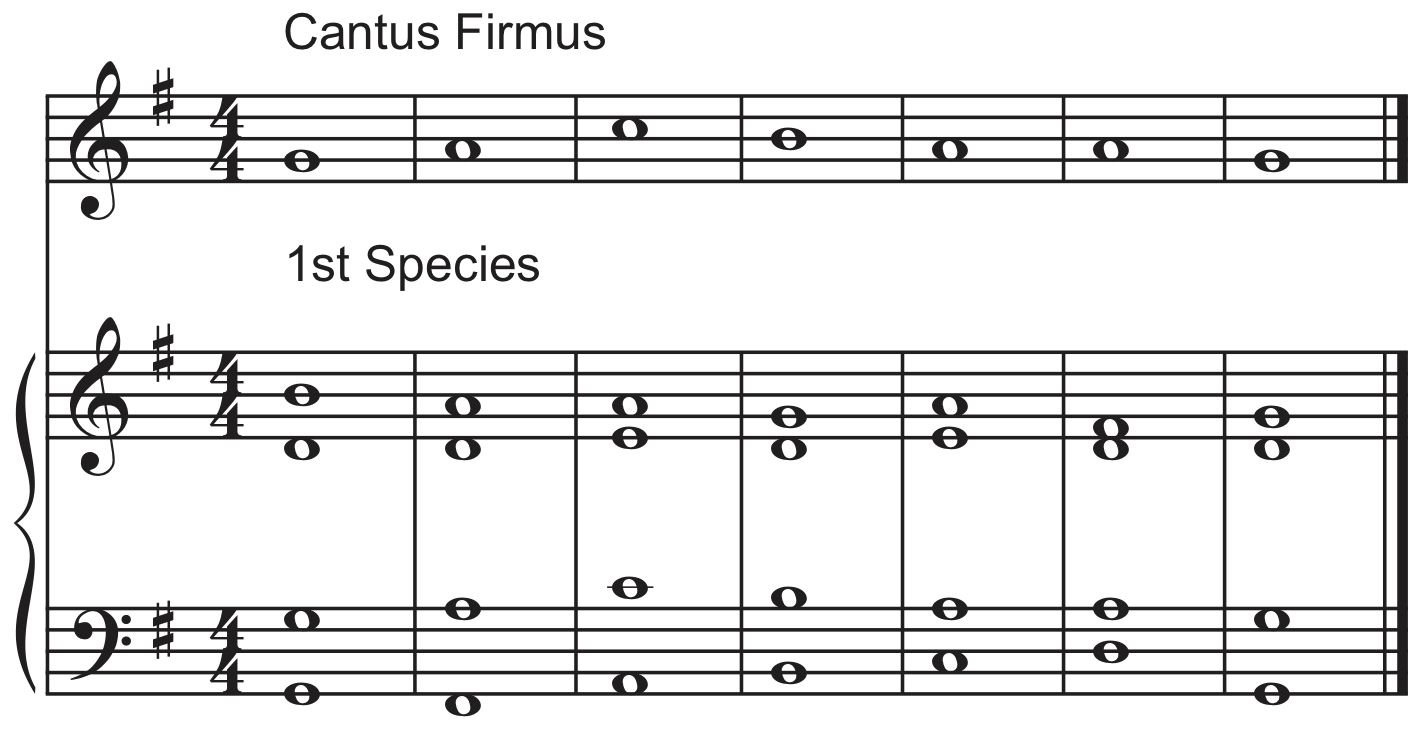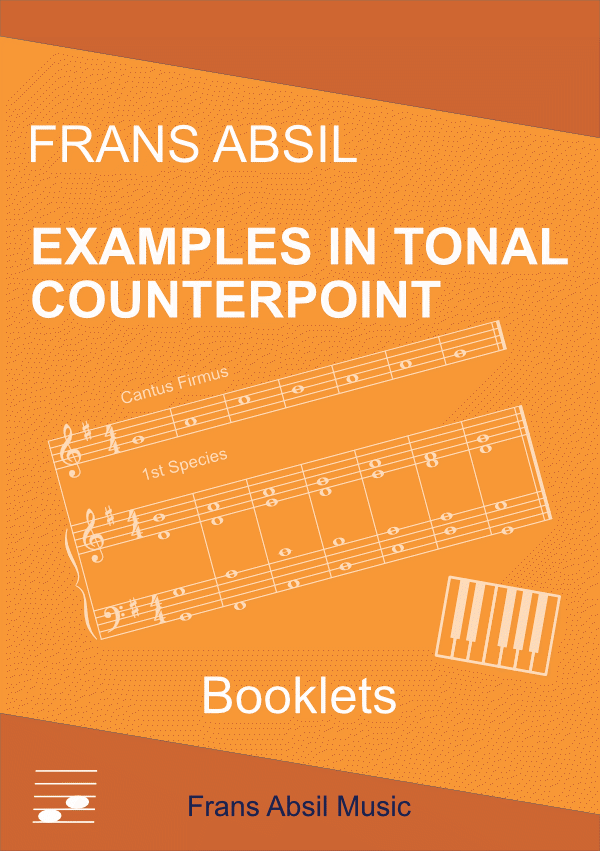Homepage > Documents > Tonal Counterpoint Examples Support this website? >>
Annotated scores for Schoenberg tonal counterpoint examples
Tonal Counterpoint Examples
Purchase the bundle of 9 volumes through PayPal (or credit card) and receive your personal copy as an e-mail attachment within 24 hours.
On this page you will find marked and annotated score examples from the Arnold Schoenberg book on tonal counterpoint (see reference). The examples are provided as a bundle of pdf-booklets (see the table with links below). The notation is explained on this page.
Introduction >> | Counterpoint Booklets >> | Notation Issues >>
Introduction
 Composer Arnold Schoenberg wrote a textbook (see reference at page bottom) to teach the fundamentals of Tonal Counterpoint. In the book Schoenberg presents and discusses the rules for writing classical, tonal counterpoint. Start with the Cantus Firmus (melodic aspects), and add the counterpoint voices (species, treatment of non-harmonic tones, melodic formulas, voice leading aspects). The book contains many examples with discussion and explanatory notes.
Composer Arnold Schoenberg wrote a textbook (see reference at page bottom) to teach the fundamentals of Tonal Counterpoint. In the book Schoenberg presents and discusses the rules for writing classical, tonal counterpoint. Start with the Cantus Firmus (melodic aspects), and add the counterpoint voices (species, treatment of non-harmonic tones, melodic formulas, voice leading aspects). The book contains many examples with discussion and explanatory notes.
However, the score examples are written in the old vocal clefs (including alto end tenor clef), and the examples must be carefully studied to see the application of the rules, find strong and weak points, etc. The usage of the old clefs makes reading difficult (I admit) and therefore, when studying the book (quite a while ago) I decided to rewrite them in treble (G) and bass clef (F) and provide marks in the score, to illustrate the aspects discussed in the text. Now, these handwritten notes have been entered in the Finale music notation software and are available as pdf-booklets with annotated score examples. The price is € 19 (for the entire set of 9 booklets, Part 1-7 plus 9-10).
Use these score examples as additional material, when studying the Schoenberg book. To me it has been most useful in training the reading and writing of counterpoint music and identifying appropriate elements in and between the individual voices.
Introduction >> | Counterpoint Booklets >> | Notation Issues >>
The counterpoint booklets
See the table below and click on the links to open the pdf-booklets with the marked examples.
| Subject / Link | Description | Document data |
|---|---|---|
| Part 1: Counterpoint in 2 Voices; 1st and 2nd species (FREE) | Simple Counterpoint in 2 Voices; first and second species (major). Examples: Ex. 1 to Ex. 18. | pdf, A4, 19 pages, 604 kb |
| Part 2: Counterpoint in 2 Voices; 3rd species | Simple Counterpoint in 2 Voices; third species (major). Examples: Ex. 21 to Ex. 26. | pdf, A4, 26 pages, 1 Mb |
| Part 3: Counterpoint in 2 Voices; 4th and 5th species | Simple Counterpoint in 2 Voices; fourth and fifth species (major). Examples: Ex. 27 to Ex. 31. | pdf, A4, 13 pages, 480 kb |
| Part 4: Counterpoint in 2 Voices: minor keys, all species | Simple Counterpoint in 2 Voices; first, second, third, fourth and fifth species (minor). Examples: Ex. 32 to Ex. 39. | pdf, A4, 10 pages, 360 kb |
| Part 5: Counterpoint in 2 Voices: cadences and modulations | Simple Counterpoint in 2 Voices; cadences and modulations (major and minor). Examples: Ex. 40 to Ex. 51. | pdf, A4, 7 pages, 360 kb |
| Part 6: Counterpoint in 3 Voices: 1st, 2nd and 3rd species | Simple Counterpoint in 3 Voices; first, second and third species (major and minor). Examples: Ex. 52 to Ex. 61. | pdf, A4, 12 pages, 476 kb |
| Part 7: Counterpoint in 3 Voices: 4th and 5th species (FREE) | Simple Counterpoint in 3 Voices; fourth and fifth species. Examples: Ex. 62 to Ex. 68. | pdf, A4, 5 pages, 224 kb |
| (to do) | Simple Counterpoint in 3 Voices; Compositional application (cadences without cantus firmus, modulation). Examples: Ex. 69 to Ex. 90. | pdf, A4, xx pages, xxx kb |
| Part 9: Counterpoint in 4 Voices; 1st, 2nd and 3rd species | Simple Counterpoint in 4 Voices; first, second and third species (major and minor). Examples: Ex. 91 to Ex. 97. | pdf, A4, 16 pages, 608 kb |
| Part 10: Counterpoint in 4 Voices; 4th and 5th species | Simple Counterpoint in 4 Voices; fourth and fifth species (major and minor). Examples: Ex. 98 to Ex. 101. | pdf, A4, 7 pages, 288 kb |
| (to do) | Simple Counterpoint in 4 Voices; Addition of voices. Examples: Ex. 101 to Ex. 110. | pdf, A4, xx pages, xxx kb |
Introduction >> | Counterpoint Booklets >> | Notation Issues >>
Notation issues
The pdf-booklets have been marked with a set of symbols. These will be described briefly:
- The Cantus Firmus (the starting voice in whole notes) is marked with C.F..
- Above the upper voice the perfect consonant intervals (fifth and octave) between the outer voices have been marked with 5 and 8, respectively. This facilitates the check on the appropriate voice leading into these consonant intervals. Forbidden: open (i.e., parallel) perfect consonants between any two voices. Good: contrary motion leading into perfect consonants. Acceptable: hidden parallel 5ths/8ths, when upper voice moves stepwise and lower voice leapwise; no problem when this happens between inner voices.
- Voice leading into the perfect octave (8) is indicated with a full line between two consecutive notes. Voice leading into the perfect fifth (5) is indicated with a dashed line between two consecutive notes.
- Non-harmonic notes are marked with +. When these occur on a strong beat, and are surrounded by two harmonic notes in stepwise motion there is a full horizontal line with hooks above the notes.
- Below the lowest voice find the harmonic analysis of the example: see the chord symbols. Chord inversions are indicated, e.g.: Am/C.
- In minor keys the melodic tendency of the 6th and 7th step of the scale will be monitored. The upward natural tendency (#6 - #7 - 1) (note the brackets) and the downward natural tendency (b7 - b6 - 5) will be marked in the score.
- Certain melodic formulas (such as the cambiata) will be indicated by labeled horizontal lines with hooks above or below the voice. The same holds for suspensions; these will be marked, e.g., 4 - 3 (where the numbers indicate the chordal functions).
- Additional aspects will be marked with text labels (e.g., OK or Weak) and/or dashed lines with hooks or arrow points (e.g., approaching the tritone, arpeggio) in the score.
However, note that the notation marks have not been used with the utmost consistency. The reader may find aspects that have not been marked in the scores. The booklets are already a great improvement to the printed examples in the book.
How to use the counterpoint booklets for developing counterpoint writing skills:
The tonal counterpoint booklets may also be used as exercises for training and developing the writing skills in tonal counterpoint. Instead of reading the annotated worked out examples, cover all staves with a card, except for the cantus firmus. Try your own solution to the problem, then compare your alternative with the original example.
Introduction >> | Counterpoint Booklets >> | Notation Issues >>
Reference
Arnold Schoenberg, Preliminary Exercises in Counterpoint, Faber and Faber Limited, London, 1963 (First published), 1970 (This edition), ISBN 571 09275 6.
More books:
- The 6th Edition of the Musical Analysis E-book >>
- The 3rd Edition of the Arranging by Examples E-book >>
- The 2nd Edition of the A Guide to Schillinger's Theory of Rhythm E-book >>
- See more documents and go to the PDF Document Library >>

